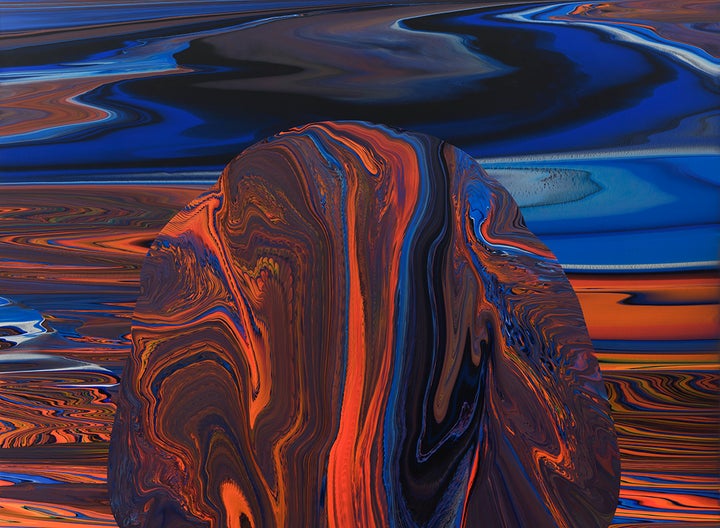
“Nature is painting for us, day after day, pictures of infinite beauty if only we have the eyes to see them.” -- John Ruskin
For Andy Moses, nature is the greatest artist. He says, “I always wanted to make paintings that didn’t emphasize the painter - to get to a natural phenomenon that is so organic that the paintings feel like they created themselves.” Moses emphasizes that we always “look through a certain lens.” He explores different optical perspectives of nature drawn from physics, art history, film and the internet which he relates to the experience of driving down the Pacific Coast Highway looking through a car window or peering out an airplane window at moving images of the Southern California coastline.

Since 2003, Moses has combined his technique of pouring paint - to create a phantasmagoria of shifting impressions and optical illusions of sea and sky - with curvilinear frames, from concaves to cantilevered parabolas. These are quintessentially L.A., because nature is most often experienced as moving images through a car’s curved windshield. By using curved canvases to imitate a fisheye lens, Moses enters the dialogue of L.A painting by introducing an ultra-wide hemispherical view that is used in meteorology for “whole sky lenses,” in scientific photography for recording auroras and meteors, and in computer-generated graphics. The different “lenses” through which we view nature have extended from the automobile to the internet and to expanded views from satellites. Moses integrates these contemporary perspectives with the history of abstract paintings to capture the elan of 21st century L.A.

Inside a studio he calls a “laboratory,” he works with the physics of paint, setting up experiments like a scientist, more interested in being surprised than leaving the stamp of his ego. Moses’ experiments with pouring paint are a discovery process he shares with the viewer - almost like an acid trip filled with hyper-real colors. His vivid blues relate to the ocean and sky while his vivid reds relate to sunsets - or freeways at night, where the red lights of traffic simulate arteries of blood. Moses’ love of 1960s psychedelic aesthetics recaptures a time period that clearly references the iconic scenes in Stanley Kubrick’s 2001: A Space Odyssey of Dr. Dave Bowman entering a black hole where time and space are compressed by two parallel universes racing toward an event horizon.
L.A.-born Moses is a legacy artist, as the son of legendary Ed Moses, from whom he learned the rigor of studio practice and an indifference to outside approval. He was immersed in a painting dialogue from childhood with his father and father’s friends from the Ferus group - who made art before there was an art scene - and ironically, became the “cool school” before being an artist was considered cool. He inherited the internal motivation of that generation, and pursued his own interests without being distracted by art trends, eventually moving ahead with his own discoveries.
Moses’ mid-career retrospective shows how his interest in optical perspectives developed from a childhood love of science textbooks and experiential observation. His early black and white paintings provide the backstory to his ongoing search for a way to use paint’s formal attributes to explore different perspectives of nature. His paintings from a period in New York (where lived from 1981 to 1999) are more obviously modeled on scientific illustrations and signifiers, and even combine texts which recall the placards at Griffith Observatory or the Jet Propulsion Laboratory. In these early experiments, he explored paint in various liquid states - even combining Turkish coffee - to create organic textures that suggest alchemic processes, fractals and parallels between micro- and macrocosmos.

The turning point from searching to discovery occurred two years after Moses returned to L.A. with his concave paintings. After living in a New York, a vertical city, Moses became more attuned to his inspirational source: the horizontal dynamic of his Southern California birthplace where the landscape is viewed in motion and the horizon line is not definable because it is impossible to see where clouds end or land begins. By adopting a curved surface, Moses could play with a three-point perspective, which is seldom used in art, although it is closer to the way we actually see nature.

Moses says, “My two big challenges are making something feel like it is in motion and creating light the way it reflects off the ocean.” The concave and convex forms change the incident of light falling on the surface in a kinesthetic way. Moses implements value and chromatic shifts in pigments - at first using only pearlescent color, which creates light and shadow as it leaves a trace of every mark. He describes this as, “almost like an X-ray of the process of making a painting.”
“I like to think I’m manifesting these paintings,” he continues. “I set up situations where I’m steering things, but sometimes the images can just appear.” Although he draws upon Jackson Pollock - who still used a brush as a way to control the fall of the paint - Moses abandons the brush altogether. He perfected a pouring technique which allows him to work with random chance, while also steering possibilities by carefully mixing the colors beforehand to set up each “experiment.” Working with wet paint requires tremendous skill, for quick decisions about the moving flow of paint that still allows the voice of paint to speak, rather than imposing a predetermined outcome. Paint is the lifeblood of Moses’ paintings, and it is his own pleasure in the discovery process of pouring wet paint across the curved surface that he recreates for the viewer to discover their own meanings.

Moses’ paintings have a strong kinesthetic quality because as we move around his work, the horizon lines change, colors change, and the light emanating from behind the surface changes - giving it a life-like quality. Moses’ paintings have clear parallels to the Light and Space movement because he explores deep space and light reflection - but these have always been the main vocabulary of serious painters. The fluidity of the paint moving across the curvilinear canvases in serpentine lines and spirals creates an unstable image which is in a constant state of flux and metamorphosis, like the natural world. Moses’ polyrhythmic paintings integrate the experiential, scientific, and theoretical lenses through which he sees nature into an exploration of the kinesthetics of moving paint on curvilinear surfaces - and by so doing, expands the dialogue of L.A painting.
Location: Santa Monica College Pete and Susan Barrett Art Gallery 1310 11th St. Santa Monica, CA 90401 +310-434-3434
Exhibition Dates: February 14 - March 25, 2017
Upcoming Events: Interconnectivity: A Musical Performance Featuring Sussan Deyhim and and Ben Neill. March 19, 2017 4.30PM. Andy Moses in Conversation with Peter Frank. March 21, 2017. 6.00PM
